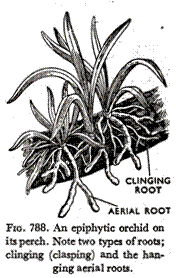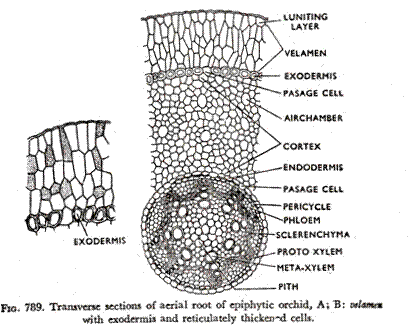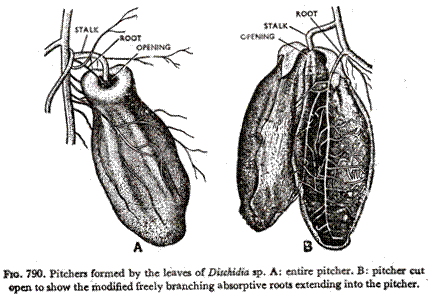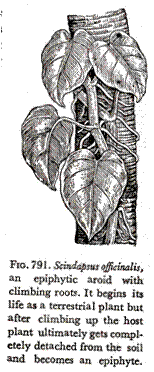ADVERTISEMENTS:
In the below mentioned article, we will discuss about epiphytes and its groups. The groups of epiphytes are: (1) Proto-epiphytes (2) Hemi-epiphytes (3) Nest Epiphytes and (4) Epiphytic Bromeliads.
Epiphytes:
Epiphytes (or aerophytes) are plants that grow upon other plants, differing from parasites in not deriving nutrients and water from the supporting host plant and from lianas (rooted vascular plants which maintain their stems in more or less erect position by making use of convenient objects for support) in not having any connections with the soil. As an ecological class, epiphytes are the most directly dependent upon rainfall, snow and dew for their water requirements.
They are sometimes capable for enduring drought conditions in absence of rain or dew. They derive their nutrient supply mainly from rainfall, accumulated wind-born dust, and smoke and also from the decaying bark surfaces of the supporting host plant.
ADVERTISEMENTS:
Epiphytes are common on trunks and limbs of trees, shrubs and even on submerged plants. Rarely, they also occur on the upper leaf surface of woody plants—epiphylls. They are generally abundant in the forks of trees, on horizontal or nearly horizontal trunks and branches but are seldom found on vertical and smooth surfaces.
The association between the supporting host plant and the epiphyte must be very loose, for neither partner gets much benefit out of this association. The epiphyte certainly is benefitted to a small degree by the food it can derive from the surface of host plant as mentioned before but what can the host plant possibly get from the epiphyte? Perhaps nothing.
Thus these associations cannot, by any stretch of imagination, be compared to symbioses, even if the water absorbed by aerial epiphytic roots could contribute (which is very doubtful) to the water requirement of the supporting plant. The epiphytic associations between terrestrial Cyanophyta and a few species of flowering plants (e.g., Gunnera) and Cycads can, however, be some sort of symbiosis for [there is certain amount of evidence that the alga (Nostoc punctiforme) separated from Cycad is scarcely capable of autotrophic nutrition] the atmospheric nitrogen fixed by the alga (Nostoc) does possibly contribute to the nitrogen requirements of the host plant. Even if we consider these associations as symbioses these are neither so highly developed nor so successful as those between legume and Rhizobium.
The greatest single factor operating against the epiphytic habit is drought and consequently, terrestrial flora is very rich in epiphytes in situations where drought is never of long duration. In cold and dry climates, epiphytes are few and chiefly represented by cryptogams, e.g., terrestrial algae, lichens, liverworts and mosses. In warm wet climates, epiphytic flora is particularly rich and a variety of vascular plants such as ferns and angiospermic families of Bromeliaceae and Orchidaceae predominate.
ADVERTISEMENTS:
The luxuriant epiphytic flora of the tropical rain forests include not only species which are shade and moisture loving (confined only to lower trunks of trees) but also xerophytic Cactaceae (e.g., Cereus) which are sometimes found on tree tops. Apparently requirement of light ranks higher to these tree-top Cereus than occasional dryness due to wind which they are adapted to endure; they sacrifice moist soil conditions in preference to bright light.
Some epiphytes seem to show marked preference of particular supporting plant, i.e., they are very selective in their choice of host partner. An interesting case is that of the moss, Tortula pogorum, which is found only on the barks of trees within the city limits.
This certainly intrigues one’s imagination. What can a plant utilise from city life? Is it higher temperature, compared to that of the wide open spaces, they crave for or do they require some constituents from air-borne dust and smoke available inside the towns, which may be essential for the growth of this epiphytic moss?
Some epiphytes grow on rocks and some even on horizontal telegraph wires as well as upon plants.
Some epiphytic ferns start their lives as rooted plants in the soil but soon, by extending their rhizomes up a readily available tree trunk, lose all connections with the ground and eventually become true epiphytes. Others such as hemlock (Tsuga) and certain figs germinate on trees and live as epiphytes during the early part of their life cycle until their roots grow down the hosts’ trunks and establish connections with the soil, when they cease to be true epiphytes.
Study of symbiotic relations between- higher plants has been largely neglected. A number of observations, however, indicate that there may be something in it. It is well- known that various epiphytic orchids and some species of Ericaceae (a family which provides many true epiphytes in the tropics) in tropical rain-forests occur exclusively on certain host trees in such constant ratio’s, that the host trees can be identified by their specific epiphytic communities.
As some epiphytes have no soil connections during their entire life history, xeromorphic adaptations such as thickened cuticles, sunken stomata, succulence (pseudobulbs or shoot tubers may often serve for water storage) and reduction in the number of leaves (in many orchids, there is only a single leaf) are common. In nest epiphytes the roots accumulate large masses of dust and debris that have water holding capacities of a soil.
The aerial roots of many tropical epiphytes belonging to Araceae or Orchidaceae extend outward into the air (Fig. 788). They are thick, un-branched, whitish structures covered on the surface by a peculiar tissue called velamen. This velamen is a special absorptive tissue that can take up water rapidly from a brief shower of rain and even from a near-saturated atmosphere, like a piece of blotting- paper soaking up water.
It is essentially a modification of many-layered epidermis, a parchment-like sheath of considerable thickness, surrounding the aerial roots. The cells of the velamen are empty (dead) and they are generally spirally or reticulately thickened. A saturated velamen root looks pale-greenish, whereas when air is dry, it looks white (Fig. 789).
ADVERTISEMENTS:
Sometimes greenish white aerial roots, 0.75-1.5 metre in length, with typical velamen-like properties are developed on the branches of some non-epiphytic species such as the showy, Vernonia monosis (Compositae). The absorbed water is stored in the velamen until absorbed by the living cells of the aerial roots.
Among epiphytic species of the family Bromeliaceae (e.g., Tillandsia), thigmotropic and often positively phototropic roots principally serve as organs of anchor for supporting the plant (clasping roots) or they may also be completely wanting, when the function of absorption of water is taken over by leaves and stems. The clasping roots consist almost exclusively of thick-walled fibres and take absolutely no part in nutrition.
In some other Tillandsia, the peltate-scale-covered finely divided shoot systems collect capillary water with the help of the absorptive scales. The water is finally absorbed by un-cutinised spots on epidermis of the leaves. The leaf bases of a few Tillandsia sp. are shaped like furrows or cavities and can collect water in their axils—tank or cistern epiphytes.
In Dischidia nummularia (Asclepiadeceae), one of the most specialised of all epiphytes inhabiting the alluvial Sunderban region, one of the leaves forms pitchers that collects and accumulates rain water and into which modified, special and freely branching absorptive roots extend. The pitchers sometimes harbour ants and other insects, the excreta and the dead remains of which may serve as a source of additional organic nitrogenous food for the plant. In Dischidia rafflesiana (Fig. 790) and in epiphytic, fern.
Asplenium nidus (bird-nest epiphyte), leaves specialised into leaf pockets, (leaves forming a rosette, enclosing a funnel-shaped cavity) help the plants to absorb humus and mineral nutrients which accumulate in the bark-surface crevices of the host support.
Only plants whose seeds are usually dispersed by wind, insects or birds to the tops and branches of trees can adopt an epiphytic mode of life.
Groups of Epiphytes:
According to their mode of life, the following four groups (mainly based on Schimper) can be distinguished:
I. Proto-epiphytes:
ADVERTISEMENTS:
A really homogeneous group and includes species that are compelled to acquire nourishment from the surface of the supporting host and from atmosphere. Examples are afforded by certain ferns, Peperomia and a number of Ascle- piadaceae. They frequently lack any definite adaptive features except perhaps aerial roots with velamen.
II. Hemi-epiphytes:
These are plants which germinate and pass through their early development on host structures but subsequently become connected with the ground by their own roots. As regards their nutrition they are subjected to the same conditions as are ordinary terrestrial plants. Examples are given by epiphytic fig trees and some root-climbing large Aroid, Scindapsus officinalis (Fig. 791).
The largest hemiepiphytes in the tropics are the species of the genus Ficus (banyan). Its roots at first are of one kind and all serve as anchoring or/and absorbing organs; later there is a sharp differentiation between short, anchoring roots and long absorbing roots. Ultimately the absorbing roots descend and make final connections with the soil.
ADVERTISEMENTS:
There are some lianes—stein climbers that germinate in the soil but their stems gradually die from below upwards, so that at maturity, they exist just like hemiepiphytes. They have been termed pseudoepiphytes.
III. Nest Epiphytes:
This group is composed of some characteristic species, which by appropriate and efficient devices collect, large quantities of humus and water. Examples are given by many orchids.
IV. Epiphytic Bromeliads:
This is a class by itself. The Bromeliaceae is a large family (over 1600 species) that is well known for its epiphytism.
The family as a whole has marked xerophytism with which are associated various absorbing systems of leaves in particular, (1) absorbing peltate scales that act as one- way valves and (2) tank formation by leaf bases.
Again, four principal ecological types of bromeliads can be recognised:
ADVERTISEMENTS:
Type I—Soil root:
The soil root type has well developed root systems and soil constitutes the exclusive source of water and mineral nutrients. They have no specialised absorbing organs. Tanks are not formed by leaf bases.
Type II—Tank root:
The leaf bases in this type retain rain water and dew. The water becomes rich in humus from decomposing vegetable or animal remains. Roots enter the soil only rarely, but a system of mycorrhizal axillary roots grow upward between expanded and overlapping leaf bases, utilising the collected water and nutrients. Perhaps most of them are not exclusively dependent upon the interfoliar roots.
Type III— Tank-absorbing trichomes:
They constitute the great majority of the bromeliads. The tank is much better equipped and is also better developed than in the preceding type. With leaves rosulate and upright, the rain and falling leaves are effectively collected in the tank. Roots merely serve to anchor the plants, absorption occurring mostly through epidermal scales.
ADVERTISEMENTS:
Some of the epiphytic plants in tropical rain forests become gigantic in size—in some plants of this type, the inflorescence may be as high as 3 metres and its tank may have as much as 5 litres of water! The tank contains a microcosm, rich in microorganisms and even hydrophytic insectivorous plants, i.e., Utricularia which flourish there, catching numerous small creatures, e.g., ants, worms, numerous protozoa, etc., in such traps.
Several sub-types are recognised:
(a) Species wholly dependent on the single tank produced.
(b) Other species produce nests as a result of vigorous vegetative propagation and the additional humic material entrapped in the nests, is utilised as well as that in the tanks;
ADVERTISEMENTS:
(c) Others, such as some Tillandsia sp. have ephemeral tanks, and
(d) There are species associated with ants that may be regarded as myrmecophilous; some of them are never found except in ant gardens.
Type IV—Atmospheric vapour, dew and dust-absorbing trichomes:
In these plants the tanks and the adventitious absorbing roots are both lacking; in Tillandsia usneoides all roots are absent. Rain and dew are absorbed by scales that usually cover the entire plant and the only source of mineral nutrients for them must be dust in the air. There is a suggestion that some species of this type have symbiotic fungi which may conceivably be nitrogen-fixers although direct evidence is lacking.
The type IV may again be broadly divided into three categories:
(1) Certain forms intermediate with type III,
(2) Those that absorb everything wholly from the atmosphere and
(3) Those that are myromecophilous.
Some authors studied the occurrence of bromeliads in the forests and divided them again into 3 main groups:
(i) Exposure group:
Consists, of species that occur at the top, i.e., in the highest levels of the forest with complete exposure to the sky. All members of this group, almost exclusively are tank-forming species but with no nest formation. Under drier conditions, the exposure group becomes predominantly atmospheric type (type IV);
(ii) Sun group:
Contains the largest number of species. These plants include both the true tank-type and the tank-nest type; they are amongst the most massive growth-type of bromeliads, and
(iii) Shade-tolerant group:
Occurs predominantly in the lower-levels of forests, even near the ground but they increase in density with increased illumination. Most of these are of the ephemeral tank-type, containing only very small amounts of water. The nest-type is absent, as it is in the exposure group.




